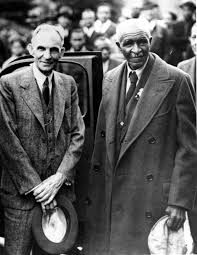George Washington Carver (1864 – January 5, 1943) was an American agricultural scientist and inventor who promoted alternative crops to cotton and methods to prevent soil depletion. He was the most prominent black scientist of the early 20th century.

While a professor at Tuskegee Institute, Carver developed techniques to improve soils depleted by repeated plantings of cotton. He wanted poor farmers to grow other crops, such as peanuts and sweet potatoes, as a source of their own food and to improve their quality of life. The most popular of his 44 practical bulletins for farmers contained 105 food recipes using peanuts. Although he spent years developing and promoting numerous products made from peanuts, none became commercially successful. https://en.wikipedia.org/wiki/George_Washington_Carver
This day in history 1942: George Washington Carver begins experimental project with Henry Ford
The agricultural chemist George Washington Carver, head of Alabama’s famed Tuskegee Institute, arrives in Dearborn, Michigan at the invitation of Henry Ford, founder of Ford Motor Company.
Born to slave parents in Missouri during the Civil War, Carver managed to get a high school education while working as a farmhand in Kansas in his late 20s. Turned away by a Kansas university because he was an African American, Carver later became the first black student at Iowa State Agricultural College in Ames, where he obtained his bachelor’s and master’s degrees. In 1896, Carver left Iowa to head the department of agriculture at the Tuskegee Normal and Industrial Institute, a school founded by the leading black educator Booker T. Washington. By convincing farmers in the South to plant peanuts as an alternative to cotton, Carver helped resuscitate the region’s agriculture; in the process, he became one of the most respected and influential scientists in the country.
Like Carver, Ford was deeply interested in the regenerative properties of soil and the potential of alternative crops such as peanuts and soybeans to produce plastics, paint, fuel and other products. Ford had long believed that the world would eventually need a substitute for gasoline, and supported the production of ethanol (or grain alcohol) as an alternative fuel. In 1942, he would showcase a car with a lightweight plastic body made from soybeans. Ford and Carver began corresponding via letter in 1934, and their mutual admiration deepened after Carver made a visit to Michigan in 1937. As Douglas Brinkley writes in “Wheels for the World,” his history of Ford, the automaker donated generously to the Tuskegee Institute, helping finance Carver’s experiments, and Carver in turn spent a period of time helping to oversee crops at the Ford plantation in Ways, Georgia.
By the time World War II began, Ford had made repeated journeys to Tuskegee to convince Carver to come to Dearborn and help him develop a synthetic rubber to help compensate for wartime rubber shortages. Carver arrived on July 19, 1942, and set up a laboratory in an old water works building in Dearborn. He and Ford experimented with different crops, including sweet potatoes and dandelions, eventually devising a way to make the rubber substitute from goldenrod, a plant weed. Carver died in January 1943, Ford in April 1947, but the relationship between their two institutions continued to flourish.
See Also
